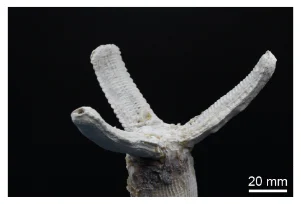Hydrogels infused with fungus mycelia have been produced by researchers at the ETH Zurich in Switzerland as a method of 3D printing a self-repairing skin. If the fungal network is allowed to metabolise, the skin will heal itself when it is damaged, and it does this by ingesting nutrients. It is a living entity since it has the ability to undergo metabolism. It is the epitome of a cybernetic organism
Over time, materials have a propensity to wear down and fail. It takes time and energy to fix them, typically in the form of maintenance that is carried out by a person. Living things, on the other hand, have the capacity to regenerate and heal themselves after damage. Consider the trunk of a tree growing, or your own skin. Of course, nutrients give living things the energy they need to rebuild themselves.
This idea has been used to create artificial skin that is infused with the Ganoderma Lucidum fungus and 3D printed in the shape of a hydrogen grid. In Asia and some regions of Europe, this kind of fungus thrives on hardwood.
In this picture, the fungus’s fruiting body is visible.

In order to create the living skin, the hydrogel was first inoculated with fungus mycelia.
Mycelium ink was created as a result of this, and it was later harvested and loaded into a direct ink writing (DIW) 3D printer. In this instance, the printed objects were grid-like structures of various shapes, and the hyphae dispersed in the ink create a linked network of fungal cells within them.
The grid structure provides gaps and airways for possible nutritional supplementation.
Any geometry of the structure can be printed, allowing for complete customization and controlling how the skin grows. Mycelium grows in accordance with the printed grid structure’s geometry, since it has evolved to fill in gaps. This characteristic also enables it to mend itself by repairing holes in its own skin. The mycelium develops using either the phalanx or guerrilla growth pattern.

A structure known as a mycelial mass or mycelial mat is created by the coordinated growth of numerous hyphae in a dense, linked network as part of the phalanx strategy (the skin). The fungus can efficiently explore and colonise new areas in quest of nourishment thanks to its limited strategy. It can also effectively protect itself from rivals and predators.
The guerilla technique, on the other hand, enables the mycelium to travel over uneven resource environments since it is more opportunistic and extensive. Mycelia that had been printed exhibited both types of growth in the printed network, which encouraged the development of a fractal hyphae network that strengthened the printed grid.
The hyphae demonstrated the ability to repair fissures up to 2 mm in width.
The researchers state that there needs to be further development into how the nutrients are provided into the printed skin, as well as how the waste is removed. In addition to the printed mycelial gripper pictured at the beginning of the article, the researchers printed a skin for an untethered robot. The combination of living skin over an artificial endoskeleton is the very definition of a cybernetic organism, at least according to James Cameron. Exciting times ahead.
You can read the full paper, titled “Self-regenerating living material made of printed fungi” published in Nature Materials at this link.
3D APAC Pty Ltd Copyright © 2023. All rights reserved